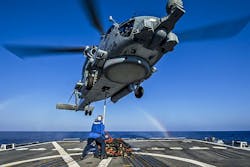Elbit to provide electro-optics helmet-mounted displays for Navy MH-60R and MH-60S helicopters
CRANE, Ind. –Electro-optics experts at Elbit Systems of America in Fort Worth, Texas, will provide the U.S. Navy with helmet-mounted displays for pilots of MH-60R anti-submarine warfare (ASW) helicopters and MH-60S multimission helicopters under terms of a $49.9 million contract announced Wednesday.
Officials of the U.S. Naval Surface Warfare Center Crane Division in Crane, Ind., are asking Elbit to provide 126 helmet display tracker systems (HDTS) for MH-60R and MH-60S helicopter pilots.
The HDTS provides MH-60 situational awareness and targeting enhancements via pilot/copilot line-of-sight capability; continuously computed impact point for the 20-millimeter automatic gun helicopter armament subsystem; LAU-61C/A 2.75-inch unguided rockets; and LAU-61G/A precision guided digital rocket launcher.
The MH-60R is an ASW and anti-surface warfare helicopter that can operate from aircraft carriers and from other surface warships equipped with helipads. The MH-60S, meanwhile, is for search-and-rescue, MEDEVAC, utility, and vertical replenishment.
The magnetic HDTS helps reduce the MH-60 helicopter pilot's workload and improve crew coordination. The HDTS represents a relatively simple upgrade to the predecessor HUD on the MH-60 rotorcraft.
Related: Elbit Systems introduces JedEyes helicopter helmet-mounted display
The MH-60's HDTS provides HUD symbology to enable the helicopter's pilots work together. The system is designed to eliminate confusion in the cockpit; drive weapon systems and control the helicopter's electro-optical sensors, and offer hands-free operation.
The Elbit HDTS can slave or slew weapons and sensors with the “big picture” rather than the “soda straw” view of a multifunction display, Elbit officials say.
The system enables MH-60 pilots to know always where sensors and weapons are looking via symbology, designates fixed points on the ground via look-and-click capability, and uses components that the military already has in stock for other helicopters and fixed-wing aircraft such as CH-47 Chinook helicopter, UH-60 Black Hawk helicopter, V-22 Osprey tiltrotor, F-22 Raptor jet fighter, and F/A-18 Hornet strike fighter.
The HDTS capability to boresight the system in the aircraft offers increased convenience for pilots over the legacy system, and eliminates the obsolete rail linkage system to improve head mobility and increase aircrew safety. The HDTS symbol set also increased heads-up capability to improve situational awareness.
On this contract Elbit will do the work in Fort Worth, Texas, and should be finished by June 2021. For more information contact Elbit systems of America online at www.elbitsystems-us.com, or the Naval Surface Warfare Center-Crane at www.navsea.navy.mil/Home/Warfare-Centers/NSWC-Crane.
Learn more: search the Aerospace & Defense Buyer's Guide for companies, new products, press releases, and videos

